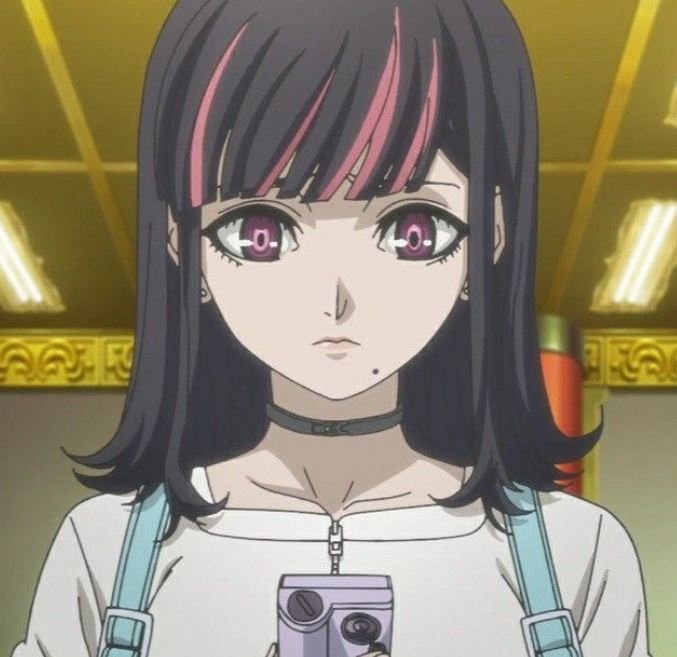
Swindler
Swindler |
|
|---|---|
 |
|
| Aliases | Ippanjin (一般人) Sagi-shi (詐欺師) The Ordinary Person The Citizen Marvelous angel (by the Cutthroat) Nauseating woman (by the Doctor) |
| Statistics | |
| Species | Human |
| Gender | Female |
| Status | Deceased |
| Place of Death | Shinkansen wreckage |
| Cause of Death | Executed by a member of the Execution Division |
| Debut | |
| Manga | Volume 1, Chapter 1 |
| Anime | Episode 1 |
| Actors | |
| Japanese | Tomoyo Kurosawa |
| English | Macy Anne Johnson |
The Ordinary Person (一般人, Ippanjin), later known as the Swindler (詐欺師, Sagi-shi), is the main protagonist of the anime series Akudama Drive. Initially introduced as a nameless, law-abiding citizen caught in the wrong place at the wrong time, she is mistakenly identified as a high-level criminal and forced into a dangerous heist alongside a group of notorious Akudama. As the story progresses, she adopts the alias “Swindler” and undergoes a significant transformation, becoming a symbol of resistance in a society plagued by corruption and authoritarian control.
Appearance

Appearance in Anime
Previous Appearance
Prior to her transformation, the Swindler appears as a young woman with a soft and youthful appearance. She has shoulder-length black hair that subtly curves outward, accented by distinct pink streaks in her bangs. Her eyes are pink, and she wears a black choker around her neck.
Her outfit consists of a pink and white short-sleeved striped dress, paired with long black fingerless gloves that extend above her elbows. She accessorizes with a light blue bracelet on her left wrist and a small light blue backpack, often worn on one shoulder. She completes her look with black thigh-high socks and pink open-toe shoes that leave her calves visible, creating a casual yet distinctive appearance.
Current Appearance
In Episode 8, Swindler drastically alters her look to evade the Executioners, cutting her hair short, including her bangs. Though her hair is now styled in a messier, cropped fashion, the pink streaks remain visible, symbolizing her retained identity despite the change.
By Episode 9, she adopts a completely new outfit, reflecting her shift in character. She wears a tight black sweater, layered over a white t-shirt visible only at the collar. Over this, she dons a blue jacket with short, puffy sleeves, decorated with white buttons and red and black streaked details along the collar and front. Her lower attire includes black shorts and high black boots with blue platforms. She continues to wear her light blue bracelet on her left wrist and adds a large white belt slung around her hips, emphasizing her more tactical and resolved presence.
Younger Appearance
In Chapter 52 of the manga adaptation, a younger version of Swindler appears in a flashback. She is seen wearing a typical Japanese school uniform and initially retains her long hair. Inspired by a school friend, she later cuts her hair into a short bob and adds the signature pink streaks to her bangs for the first time, marking the early formation of her distinctive look.
Personality
Initially introduced as an ordinary and law-abiding citizen, the Swindler stands in stark contrast to the hardened criminals known as the Akudama. She is compassionate, morally grounded, and deeply empathetic, often going out of her way to help others even those she has just met. Though easily flustered in the face of danger, she consistently demonstrates a willingness to push forward when she believes something is right. Her quick thinking and improvisational skills often play a vital role in getting the group out of difficult situations.
As someone thrust into the chaotic and violent underworld of Kansai, the Swindler initially struggles to comprehend the logic of hardened criminals or the corruption surrounding them. Her reactions often reflect naivety and panic, especially when confronted with brutality or morally ambiguous decisions. She frequently overreacts or exaggerates her emotions in tense moments, attempting to cope with the intensity of her new environment while preserving her own sense of identity.
However, over the course of the series, the Swindler undergoes a dramatic evolution. After becoming a caretaker for Brother and Sister, she begins to abandon her pacifism, showing a growing willingness to use violence and manipulation to protect them. This transformation is first seen when she kills human traffickers to shield Sister, and later when she exploits her S-rank Akudama status and infamous reputation to incite mass panic and upheaval in Kansai creating a distraction to save Brother.
By this point, she no longer acts solely out of fear or instinct. She adopts a more composed and strategic mindset, embracing her role within the Akudama narrative. In her own words, she begins to “enjoy” her infamy, suggesting that she has accepted and internalized her identity as a symbol of rebellion and chaos.
Her new level-headedness is especially evident during her confrontation with Cutthroat, where she coolly outmaneuvers and ultimately defeats him by planning a successful trap, an act that demonstrates her growing intelligence, decisiveness, and emotional resilience.
Background
Before becoming entangled in the world of crime and chaos, the Swindler was simply an ordinary young woman living a quiet and uneventful life in Kansai. She had no criminal record, no violent tendencies, and no connection to the underground world of Akudama. Her life took a drastic turn after a chance encounter with Courier and an impulsive decision to help a stranded cat, which ultimately pulled her into a high-stakes mission involving six of the most dangerous Akudama in Kansai.
Mistaken for a criminal due to her sudden involvement, she quickly adopts the alias “Swindler” to avoid suspicion and survive. When questioned about her nonexistent records in the Kansai Central Information Bureau, she boldly claims to have “erased” her own data, inadvertently convincing the others that she is a highly skilled and elusive criminal. Her bluff works, and she is accepted as part of the group, despite lacking combat skills or a criminal background.
From that point forward, she continues to impersonate a high-level Akudama, using her wit, emotional intelligence, and growing resilience to navigate life-threatening situations and increasingly blurred moral lines.
Abilities
Initially introduced as an ordinary person with no combat training, criminal background, or special talents, the Swindler begins the story as a regular young woman living a mundane life. In Episode 11, she reflects on her simple routines returning from work, preparing food, and relaxing at home highlighting her peaceful existence before being swept into the world of Akudama.
However, under the fabricated identity of an Akudama known as the “Swindler,” she gradually develops the mental resilience, cunning, and emotional intelligence needed to survive among dangerous criminals. Her first act of deception claiming to have erased her records from the Kansai Central Information Bureau earns her unearned credibility, allowing her to remain with the group under false pretenses.
Over time, she begins to truly embody the role of a swindler. Her manipulations, whether intentional or not, prove effective in influencing others. The Doctor, for instance, views her compassion for Brother and Sister as an act of manipulation and regards her speeches as calculated. These moments of persuasion become a key aspect of her strategy, as seen when she echoes Courier’s desire for belonging to earn his cooperation, or invokes Brawler’s legacy to convince Hoodlum to defy the Doctor.
Though she begins without any physical capabilities, the Swindler adapts to high-risk environments with increasing confidence. She demonstrates quick thinking and risk tolerance, such as when she climbs into the Shinkansen cargo at the risk of being killed by weight detection systems. As her journey progresses, she learns to confront danger head-on: fighting off assailants, using firearms, and defending Sister from threats despite lacking formal combat training.
Ultimately, her transformation into a true Akudama culminates in her final act of rebellion. Using her public infamy, she incites chaos in Kansai by declaring on a public broadcast that she and the Akudama plan to start a war. Moments later, she reclaims her identity as an ordinary person just before her execution, exposing the state’s hypocrisy and sparking mass unrest.
While not possessing supernatural powers or expert combat skills, the Swindler’s greatest strength lies in her adaptability, intelligence, and ability to weaponize perception transforming from an unremarkable civilian into a revolutionary symbol through sheer will and resolve.
Legacy
The Swindler’s death serves as the catalyst for widespread rebellion across Kansai. After her execution was broadcast publicly paired with her final statement declaring herself to be merely an ordinary person citizens across the region became aware of the corruption and brutality of the Executioners and the state-controlled system. The shocking realization that innocents were being labeled as Akudama and executed led the population to rise up in protest.
Fueled by anger and disillusionment, the citizens took violent revenge, leading to the deaths of all active Executioners and their commanding officer, Boss. The uprising marked a pivotal shift in Kansai’s societal structure, with Swindler’s sacrifice becoming a symbol of resistance against authoritarian oppression.
Her influence extended to the very end of the story, particularly through Courier, who, despite his stoic nature, ultimately embraced the cause she had come to represent. In his final moments, Courier sacrifices himself to ensure Brother and Sister’s escape, handing them the ¥500 coin that once played a small but significant role in Swindler’s journey. The gesture symbolizes not only hope and continuity, but also the belief that even the smallest act can change a life, just as it had for Swindler.
Through her transformation from an ordinary person to a revolutionary figure, Swindler leaves behind a powerful legacy one that inspires rebellion, demands justice, and restores the agency of those once silenced.